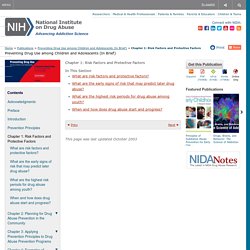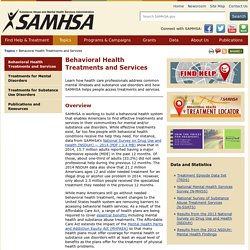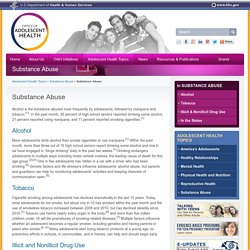

Substance Abuse in Young Adolescents
HRC Final Issue Brief. Chapter 1: Risk Factors and Protective Factors. Skip to main content En español Home » Publications » Preventing Drug Use among Children and Adolescents (In Brief) » Chapter 1: Risk Factors and Protective Factors Preventing Drug Use among Children and Adolescents (In Brief) Chapter 1: Risk Factors and Protective Factors In This Section Prev Index Next This page was last updated October 2003 Contents Ordering Publications Call 1-877-643-2644 or: Get this Publication Featured Publications Principles of Substance Abuse Prevention for Early Chil...

Drugs, Brains, and Behavior: The Science of Addiction Marijuana: Facts Parents Need to Know Marijuana: Facts for Teens More AddThis Sharing Sidebar. What are the highest risk periods for drug abuse among youth? Factors That Influence Teenagers to Substance Abuse. Many teenagers get high from abusing substances which range from diverted prescription drugs to street drugs to inhalants to alcohol.

Some of these teens will go on to a life of addiction, abusing increasingly dangerous substances. Some teens will have more short-lived experience, as abusing a drug or other substance even one time can be fatal. Parents and interested adults should examine the factors that lead teenagers to abuse substances in an effort to prevent this risky behavior. The National Institute on Drug Abuse reports that peers have a large influence on drug-abusing behavior. Many teens use drugs for the first time to avoid being stigmatized by their friends or to impress others.
According to the National Institute on Drug Abuse, scientists recognize that genetic predispositions to drug abuse exist, but they have yet to pinpoint the specific genes involved. Some teens, like some adults, reach for substances as an attempt to relieve stress. Quickly and easily curate content. National Institute on Drug Abuse (NIDA)
Behavioral Health Treatments and Services. Overview SAMHSA is working to build a behavioral health system that enables Americans to find effective treatments and services in their communities for mental and/or substance use disorders.

While effective treatments exist, far too few people with behavioral health conditions receive the help they need. For instance, data from SAMHSA’s National Survey on Drug Use and Health (NSDUH) — 2014 (PDF | 3.4 MB) show that in 2014, 15.7 million adults reported having a major depressive episode (MDE) in the past 12 months. Of those, about one-third of adults (33.2%) did not seek professional help during the previous 12 months. The 2014 NSDUH data also show that 21.2 million Americans ages 12 and older needed treatment for an illegal drug or alcohol use problem in 2014. While many Americans still go without needed behavioral health treatment, recent changes to the United States health system are removing barriers to accessing behavioral health services. Substance Abuse - The Office of Adolescent Health. Alcohol is the substance abused most frequently by adolescents, followed by marijuana and tobacco.[1] In the past month, 35 percent of high school seniors reported drinking some alcohol, 21 percent reported using marijuana, and 11 percent reported smoking cigarettes.[1] Alcohol More adolescents drink alcohol than smoke cigarettes or use marijuana.[1] Within the past month, more than three out of 10 high school seniors report drinking some alcohol and one in six have engaged in “binge drinking” daily in the past two weeks.[1] Drinking endangers adolescents in multiple ways including motor vehicle crashes, the leading cause of death for this age group.[2],[3] One in five adolescents has ridden in a car with a driver who had been drinking.[4] Genetic factors and life stressors influence adolescents’ alcohol abuse, but parents and guardians can help by monitoring adolescents’ activities and keeping channels of communication open.[5] Tobacco Illicit and Nonillicit Drug Use [1] Johnston, L.

Risk & Protective Factors - The Office of Adolescent Health. Approximately 5.6 million adolescents who are currently under the age of 18 will die prematurely due to a smoking-related illness.[1] There are several characteristics and risks associated with tobacco use and with difficulty quitting – many of these factors are applicable not only to adolescents but to all individuals, regardless of age.

Factors associated with likelihood to smoke or use tobacco Numerous factors influence adolescents’ decisions to start smoking or to use other tobacco products. These factors include some individual characteristics, such as stress and low self-esteem, but also social characteristics, such as having parents,[3] siblings, or friends who smoke.[4] Exposure and susceptibility to tobacco advertising can also affect smoking initiation among adolescents.[5] Certain characteristics increase the likelihood that an adolescent will smoke: Older age.
Being male. Being white, multi-ethnic, American-Indian, or Alaska Native. Lacking college plans. Perception of Risk.